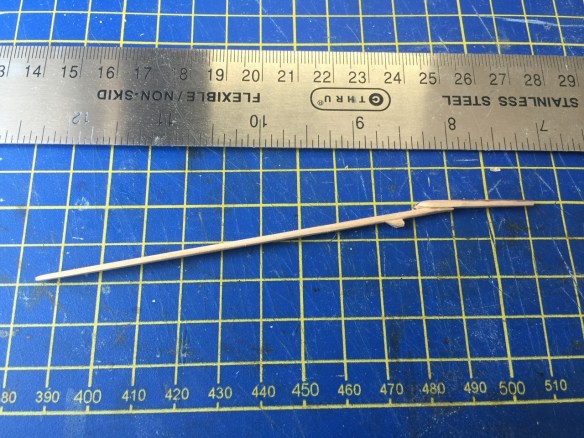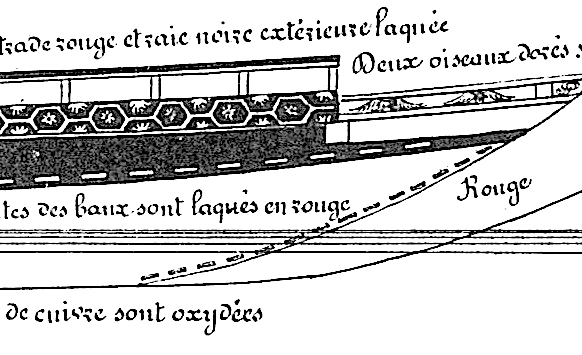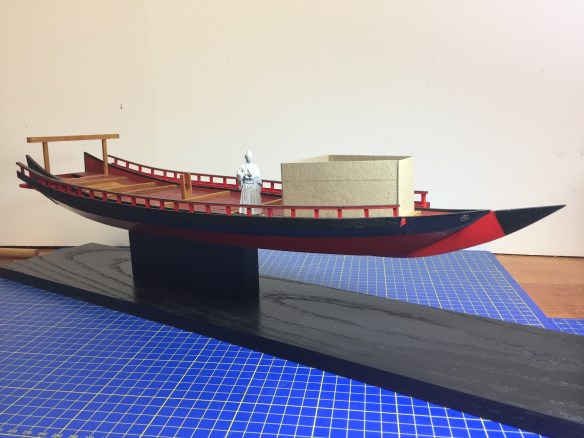







Note the pattern of the chain of hexagons and what look like little sunbursts in the Paris drawings.

The restored yakata from the Naminashi-maru at the museum of Kumamoto Castle.

So, I drilled out the rogui on which the ro, or sculling oars, pivot. I used a sharp point to start the hole and finished up using a small drill in a Dremel rotary tool. Because I’m starting to consider painting the model, I’m going to hold off on adding the pins to the rogui until some later time.
Also, I found more structural work to complete before I have to deal with the rails, so I’m putting that assembly off for the moment.
Finishing Mortises
Today, I finished the remaining mortises. I did these the same way as the ones done earlier, laying out strips of tape to maintain even spacing, but the mortises at the todate (transom) and the miyoshi (stem), were a little smaller and slightly closer together.
Mortises
While I’m waiting for the urushi, there is still more work to do on the hull, as well as more design problem solving as well. The main feature needed next are all the mortises. Mostly these are along the bottom edge of the upper hull plank. In addition, for the lower planks, there are mortises at the bow and stern edges. Technically, there would also be mortises at the bow edge of the upper plank and ones all along the bottom edge of the lower plank. But, these apparently do not have metal plates covering them. Most likely, these are plugged and painted over, so you wouldn’t see them anyway.
These mortises measure out to be approximately 5mm long at this scale, with a 4mm separation between them. To help position these evenly, I first lined the edge of the plank with tape, tryng to keep and even alignment about 2mm from the edge of the plank.
I then took some more tape and cut two long strips, one 5mm wide and another 4mm wide. From this I cut short strips crosswise and laid them into place, alternately, to create a pattern for the positions of the mortises. To cut the mortises, I used a 5mm wide Japanese carving chisel and a second chisel that I ground down to a width to 1mm.
Below, you can see some of the mortises I cut and the pattern of tape I used to create the proper spacing. the section on the right has been completed and the tape removed. On the left, I have yet to start cutting.
The Paint Scheme from Paris
Having made some great progress on the model, it’s time to begin consideration of the paint scheme. From the very start, as a gozabune, it’s been very clear that this is a highly ornate ship, painted in black and vivid red lacquers, and decorated with gold trim.
I’ve noted that modeler Yukio Nakayama’s gozabune models, as well as those made by other Japanese ship modelers, are painted inside and out. Pretty much everything except the decks. This left me wondering how I would end up finishing this model.
I’ve been in a quandary because I do like the look of the interior painted bulwarks and beams with the bare wood deck. But, I recently looked more closely at the notes on the Paris drawings and discovered that interior painting information is actually there in addition to the exterior info.
The Rudder
One of the sub-assemblies that can easily be worked on at any time is the large rudder. The detail in the drawings is very simple, but I felt that it should be very similar to other large rudders used on larger vessels. With the
I made mine from three planks glued edge to edge and cut to the shape of the plans. I then attached a rudder post that I cut round and then tapered toward the bottom. To hold the planks of the rudder together, I took example from the Woody Joe Higaki Kaisen kit I built a few years ago, and added three cross-pieces as shown in the following photo.
I don’t know what amount of detail to add yet, so I just left the rudder assembly as is. Continue reading